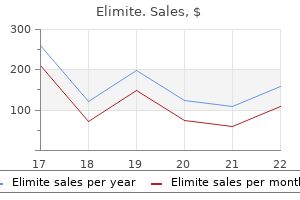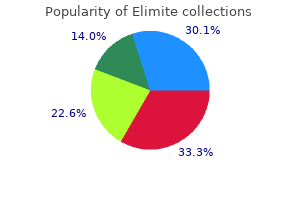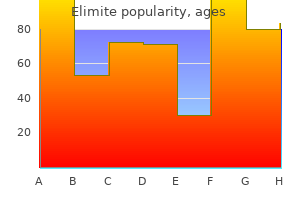Karen S. Pieper, MS
- Senior Statistician
- Duke Clinical Research Institute
- Department of Medicine, Division of Cardiology
- Duke University Medical Center
- Durham, North Carolina
Size-appropriate resuscitation equipment should be readily available acne vulgaris definition order discount elimite online, including ventilation bag and mask acne dark spot remover discount elimite 30 gm free shipping, oxygen skin care educator jobs best order for elimite, and resuscitation medications acne jaw line buy elimite without a prescription. Neurologic status and treatment effect can be assessed with verbal and mild tactile stimuli. Monitoring of a patient receiving these medications for pharmacologic anxiolysis should include continuous pulse oximetry, visual assessment of ventilation, and noninvasive blood pressure measurement every 5 minutes. Continuous monitoring of arterial blood pressure is too invasive for this setting. Because these medications generally have minimal effect on cardiac conduction, electrocardiographic monitoring is not required in the absence of significant preexisting cardiovascular disease. Noninvasive capnography by nasal cannula is sometimes used in conscious sedation for procedures involving decreased access for visual monitoring, such as magnetic resonance imaging. Monitoring of exhaled tidal volume would require endotracheal intubation, which is usually not necessary in sedations short of general anesthesia. Monitoring of the pupillary response is not necessary unless an overdose is suspected. Guidelines for monitoring and management of pediatric patients during and after sedation for diagnostic and therapeutic procedures: addendum. On physical examination, he is irritable, has nuchal rigidity, and several insect bites are noted over his legs. The term arbovirus is an abbreviation of arthropod-borne viruses, which alludes to the vectors of transmission (mosquitoes, ticks, sand flies, and midges). Transmission usually occurs between birds or small mammals and the arthropod vectors. Infections in humans and domestic animals do not maintain transmission for most arboviruses. For West Nile virus, birds serve as a reservoir, and avian-mosquito-avian cycles maintain transmission. West Nile virus infections in humans and horses are considered dead end infections. In dengue, chikungunya, and yellow fever, arthropods that feed on infected humans can then infect other humans. Most infections occur in the summer or early fall, which coincides with peak mosquito activity. Although most infections caused by arboviruses are subclinical, they can manifest as an acute febrile illness or neurologic disease. Manifestations during the acute febrile illness can be nonspecific and include headaches, myalgias, arthralgias, and exanthems. Some arboviruses have a predilection for causing particular symptoms, such as the severe joint pain seen in chikungunya virus infection, and bone pain and retro-orbital headache seen in dengue fever. Neuroinvasive disease occurs in less than 1% of those that are infected with West Nile virus. Manifestations can range from aseptic meningitis to encephalitis and even flaccid paralysis. Although most individuals have asymptomatic infection, La Crosse virus can cause severe neurologic disease, especially in children. In general, severe manifestations of arbovirus infections tend to occur more commonly in adults compared to children. Her record shows physical examinations on previous encounters remarkable only for palpable purpuric macules on the legs. Further studies include renal ultrasonography and serum chemistry, which were normal when last checked 6 weeks ago. Her physical examination is significant for palpable purpuric macules on the legs with occasional confluence. Proteinuria (mild and non-nephrotic), with and without hematuria, is more common than nephrotic range proteinuria. Nephrotic syndrome (proteinuria, hypoalbuminemia, and edema) is present in only a minority of the patients. As the majority of the patients develop renal manifestations in the first month, weekly urinalysis in the first 4 weeks will lead to early identification of renal involvement. Patients with nephritic or nephrotic syndrome have a higher risk of developing chronic kidney disease (10%-20%), compared to patients with persistent hematuria or proteinuria that does not fall into the nephrotic or nephritic range (around 2%). Patients with renal manifestations associated with increased risk for chronic kidney disease merit frequent urinalysis and should be managed in consultation with a pediatric nephrologist. The infant is currently receiving a partially hydrolyzed formula concentrated to 24 kcal/oz. Fat requirements vary by age, with higher needs in infancy that slowly decrease as children pass 2 years of age (Item C127). Premature infants and infants have fat malabsorption, resulting in increased needs that begin to decrease by 6 months of age. Fats are needed in our diet to provide essential fatty acids and to assist with the absorption of fat soluble vitamins (vitamins A, D, E, and K). Children have increased dietary fat requirements for several reasons, including fat malabsorption, failure to thrive, and increased metabolic demand. Children with complex congenital heart disease must frequently limit their daily volume intake, and additional calories from fats allow for adequate calories while respecting fluid limitations. Fat and fatty acid requirements and recommendations for infants 0-2 years and children of 2-18 years. A physical examination reveals macrocephaly, numerous skin tags, 3 to 4 palpable soft nodules on his arms and legs, 2 capillary hemangiomas on his right leg, and unusual freckling to his penis. The mother reports that she has a history of a thyroid goiter, breast cancer, and uterine fibroids. They can also have macrocephaly, trichilemmomas (a benign cutaneous neoplasm developing from hair follicles), oral papillomas, and papillomatous papules that present by the second to third decade of life. The lifetime risk for developing specific patterns of cancers is: breast cancer, 85%; epithelial thyroid cancer, 35%; and endometrial cancer, 28%. Other benign tumors commonly seen include lipomas, hamartomatous intestinal polyps, fibromas, and uterine fibroids. Consensus diagnostic criteria for Cowden syndrome have been developed by the National Comprehensive Cancer Network. Beckwith-Wiedemann syndrome is an overgrowth disorder manifested by macrosomia, macroglossia, neonatal hypoglycemia, ear creases and pits, hemihypertrophy, and visceromegaly. Patients also can have embryonal tumors (Wilms tumor, hepatoblastoma, neuroblastoma), umbilical hernia or omphalocele, nephrocalcinosis, medullary sponge kidney disease, cardiomegaly, and nephromegaly. Traditionally, the macrosomia, macroglossia, and hypoglycemia are noted in the neonatal period. Klippel-Trenaunay syndrome is a condition that impacts the development of blood vessels, soft tissues, and bones with 3 classic features that include a port-wine stain of 1 limb (typically 1 leg), abnormal overgrowth of soft tissues and bones, and venous malformations (varicose veins and a predisposition to deep vein thrombosis). Facial dysmorphology is characterized by sparse frontotemporal hair, high bossed forehead, downslanting palpebral fissures, a long narrow face, and a prominent narrow jaw. It does not typically manifest as hemihyperplasia, but a generalized overgrowth of the body. This presentation can place patients or other family members at high risk for particular forms of cancer, intellectual disability, and autism. The infant was born at full term without complications and has no medical problems. He has been growing appropriately and the remainder of his physical examination is unremarkable. Undescended testis or cryptorchidism is common and is defined by failure of 1 or both testes to descend along the normal pathway into the scrotum. The testis usually begins this abdominal-to inguinal-to-scrotal descent at 28 weeks of gestation.

Neuroglycopenic manifestations are often nes skin care 360 cheap elimite master card, glucosidase inhibitors skin care vietnam buy online elimite, glucagon-like peptide-1 observable acne 7 day detox generic 30gm elimite. However skin care trends order elimite 30 gm with amex, they increase the risk when combined with etiology and PathoPhysiology an insulin secretagogue, such as one of the sulfonylureas or glinides, or with insulin. Defec 311 tive glucose counterregulation compromises physiologic the conventional risk factors for hypoglycemia in dia defense (particularly decrements in insulin and incre betes are based on the premise that relative or absolute ments in glucagon and epinephrine), and hypoglycemia insulin excess is the sole determinant of risk. Relative unawareness compromises behavioral defense (ingestion or absolute insulin excess occurs when (1) insulin (or of carbohydrate). However, these conventional risk factors els, the third defense against hypoglycemia, in response alone explain a minority of episodes; other factors are to a given level of hypoglycemia is typically attenu typically involved. The glycemic threshold for the sympathoadrenal (adrenomedullary epinephrine and sympathetic neural norepinephrine) response is shifted to lower plasma glu Hypoglycemia-associated autonomic failure cose concentrations. That is typically the result of recent While marked insulin excess alone can cause hypo antecedent iatrogenic hypoglycemia. In the setting of glycemia, iatrogenic hypoglycemia in diabetes is typi absent decrements in insulin and of absent increments cally the result of the interplay of relative or absolute in glucagon, the attenuated increment in epinephrine therapeutic insulin excess and compromised physi causes the clinical syndrome of defective glucose coun ologic and behavioral defenses against falling plasma terregulation. Some betes compared with those with normal epinephrine what surprisingly, all three studies found little or no beneft responses. Whether iatrogenic hypoglycemia was the cause Hypoglycemia unawareness of the increased mortality is not known. In the light of the attenuated sympathoadrenal response (largely the the above fndings, new recommendations and para reduced sympathetic neural response) to hypoglycemia digms have been formulated. Whereas there is little causes the clinical syndrome of hypoglycemia unaware debate regarding the need to reduce hyperglycemia in ness, i. Affected patients hyperglycemia can be obtained while reducing the prev are at a sixfold increased risk of severe iatrogenic hypo alence of hypoglycemia. These benefts need to be Hypoglycemia-associated autonomic failure weighed against the increased prevalence of hypogly the concept of hypoglycemia-associated autonomic cemia. These impaired cause severe hypoglycemia and preserves awareness of responses create a vicious cycle of recurrent iatrogenic hypoglycemia. Hypoglycemia unawareness, Pancreatic transplantation (both whole organ and and to some extent the reduced epinephrine compo islet cells) has been used as a treatment option for recur nent of defective glucose counterregulation, is revers rent severe hypoglycemia. Other interventions to stimulate cedent hypoglycemia, as well as prior exercise or sleep, counterregulatory responses such as terbutaline, fuox that indicates that the sympathoadrenal response will be etine, thiazolidinediones, or fructose remain experimental attenuated; and (3) lower HbA1C levels or lower glyce and have not been subjected to large-scale clinical trials. Given a history plasma glucose values toward physiologic levels resulted of hypoglycemia unawareness, a 2 to 3-week period of in increased mortality. Increased glucose utilization is induced by cytokine There are many causes of hypoglycemia (Table 20-1). Cytokine-induced inhibi assume that a clinically suspicious episode was the result tion of gluconeogenesis in the setting of nutritional gly of hypoglycemia. In the absence Hormone defciencies of any of these and in a seemingly well individual, the Neither cortisol nor growth hormone is critical to the focus should shift to the possibilities of endogenous prevention of hypoglycemia, at least in adults. None hyperinsulinism or accidental, surreptitious, or even theless, hypoglycemia can occur with prolonged fasting malicious hypoglycemia. Anorexia and weight loss Drugs are typical features of chronic cortisol defciency and Insulin and insulin secretagogues suppress glucose pro likely result in glycogen depletion. Ethanol blocks associated with impaired gluconeogenesis and low levels gluconeogenesis but not glycogenolysis. Thus, alcohol of gluconeogenic precursors, suggesting that substrate induced hypoglycemia typically occurs after a several limited gluconeogenesis, in the setting of glycogen deple day ethanol binge during which the person eats little tion, is the cause of hypoglycemia. In usually measurable in blood at the time of presentation, addition to extended fasting, high rates of glucose utiliza but its levels correlate poorly with plasma glucose con tion. Hypoglycemia is not a feature of the epinephrine A large number of other drugs have been associated defcient state that results from bilateral adrenalectomy, with hypoglycemia. These include commonly used when glucocorticoid replacement is adequate, nor does drugs such as angiotensin-converting enzyme inhibi it occur during pharmacologic adrenergic blockade tors and angiotensin receptor antagonists, adrenergic when other glucoregulatory systems are intact. Com receptor antagonists, quinolone antibiotics, indometha bined defciencies of glucagon and epinephrine play a cin, quinine, and sulfonamides, among many others. Otherwise, defciencies of these hormones are Critical illness not usually considered in the differential diagnosis of a Among hospitalized patients, serious illnesses such as hypoglycemic disorder. Although the kidneys are a source of patterns resemble those of hyperinsulinism (see next sec glucose production, hypoglycemia in patients with renal tion), but insulin secretion is suppressed appropriately failure is also caused by the reduced clearance of insulin during hypoglycemia. In most instances, hypoglycemia and reduced mobilization of gluconeogenic precursors is due to overproduction of an incompletely processed in renal failure. Serial sampling during an up to ing proteins and thus more readily gains access to tar 72-h inpatient diagnostic fast or following a mixed meal get tissues. Therapy plasma glucose concentration during a symptomatic epi with a glucocorticoid, growth hormone, or both has sode indicates that the symptoms are not the result of also been reported to alleviate hypoglycemia. However, insulin Endogenous hyperinsulinism oma is not the only cause of endogenous hyperinsulinism. Hypoglycemia due to endogenous hyperinsulinism can Some patients with fasting endogenous hyperinsulin be caused by (1) a primary beta-cell disorder, typically a emic hypoglycemia have diffuse islet involvement with beta-cell tumor (insulinoma), sometimes multiple insu beta-cell hypertrophy and sometimes hyperplasia. This linomas, or a functional beta-cell disorder with beta-cell pattern is commonly referred to as nesidioblastosis, hypertrophy or hyperplasia; (2) an antibody to insulin or although the fnding of beta cells budding from ducts to the insulin receptor; (3) a beta-cell secretagogue such is not invariably present. Other patients have a similar as a sulfonylurea; or (4) perhaps ectopic insulin secre islet pattern but postprandial hypoglycemia, a disor tion among other very rare mechanisms. It most often follows Roux en Y order or an insulin secretagogue is the failure of insulin gastric bypass. Some have suggested that exaggerated secretion to fall to very low levels during hypoglycemia. If medical treatments such as an to produce insulin), proinsulin, and glucose concen glucosidase inhibitor or octreotide fail, partial pancre trations during hypoglycemia. Autoimmune hypoglycemias proinsulin levels need not be high relative to normal, include those caused by an antibody to insulin, which euglycemic values; they are inappropriately high in the gradually disassociates, leading to late postprandial hypo setting of a low plasma glucose concentration. Alternatively, an insulin receptor antibody diagnostic fndings are a plasma insulin concentration can function as an agonist. The presence of an insulin 3 U/mL (18 pmol/L), a plasma C-peptide concen secretagogue, such as a sulfonylurea or a glinide, results tration 0. A low plasma hydroxybutyrate ena include ectopic insulin secretion, a gain of func concentration (2. More than 99% of insuli the episode and seek their resolution following correc nomas are within the substance of the pancreas, and they tion of hypoglycemia by intravenous injection of gluca are usually small (90% <2. This approach to clinical attention because of hypoglycemia rather is straightforward if the patient is hypoglycemic during than mass effects. These methods detect metasta ders usually, but not invariably, cause fasting hypoglyce ses in the roughly 10% of patients with a malignant insu mia, a diagnostic episode may develop after a relatively linoma. Transabdominal ultrasound will often identify insulinomas, and endoscopic ultrasound has a sensitiv 315 Recognition and documentation ity of about 90%. Somatostatin receptor scintigraphy is Hypoglycemia is suspected in patients with typical thought to detect insulinomas in about half of patients. Blood should lin levels, regionalizes insulinomas with high sensitivity, be drawn, whenever possible, before the administra but this invasive procedure is seldom necessary except tion of glucose to allow documentation of a low plasma to confrm endogenous hyperinsulinism in the diffuse glucose concentration. Diazoxide, which level excludes hypoglycemia as the cause of the symp inhibits insulin secretion, or the somatostatin analogue toms. Factitious hypoglycemia, When the history suggests prior hypoglycemia, and caused by surreptitious or even malicious administration a potential mechanism is not apparent, the diagnos of insulin or an insulin secretagogue, shares many clinical tic strategy is to measure these values and assess for and laboratory features with insulinoma. On the other hand, while it cannot be ignored, a tes or their relatives, and people with a history of other distinctly low plasma glucose concentration measured factitious illnesses. However, it should be considered in in a patient without corresponding symptoms raises the all patients being evaluated for hypoglycemia of obscure possibility of an artifact (pseudohypoglycemia).

There are several faint brownish macules with a collarette of scale in the perioral area (Item Q249) acne wash with benzoyl peroxide purchase elimite with american express. The distribution of lesions most commonly involves the chin acne treatment for teens order 30 gm elimite fast delivery, forehead acne kit cheap elimite online mastercard, neck skin care untuk kulit berminyak generic 30gm elimite with mastercard, lower back, and shins, but may be diffuse. Differentiating this benign condition from other pustular eruptions seen in newborns is important because of the potential for serious illness if the infant has a congenital infection. Laboratory findings can be helpful in corroborating or excluding suspected clinical diagnoses. Congenital candidiasis presents at birth or in the first few days after birth as a diffuse erythematous papular, pustular, exfoliating rash that may involve the palms and soles. Potassium hydroxide preparation of the pustular material reveals pseudohyphae or spores and Candida spp will be found on culture. Erythema toxicum neonatorum is characterized by evanescent blotchy erythematous macules in combination with 1 to 3-mm papules and pustules that occur predominantly on the face, trunk, and extremities, sparing the palms and soles. Cytologic examination of a smear from a pustule will reveal a predominance of eosinophils on Wright or Giemsa stain and culture will be negative. Impetigo neonatorum usually presents as superficial vesicular, pustular, or bullous lesions on an erythematous base. These lesions are easily ruptured, leaving a denuded red moist surface with later crust formation. Gram-positive cocci and neutrophils will be seen on Gram stain and a culture will yield streptococci or staphylococci. Pinpoint 1 to 2-mm clear vesicles without surrounding erythema are characteristic of miliaria crystallina. Miliaria is most often distributed in the intertriginous regions, on the face, or areas that have been occluded, such as the upper back, and usually is associated with warming of the infant. Lymphocytes may be seen on Wright stain or Gram stain of a smear of the contents of a miliaria vesicle and culture is negative. In: Hurwitz Clinical Pediatric Dermatology: A Textbook of Skin Disorders of Childhood and Adolescence. She has not been sexually active, has not been taking birth control pills, has not been on any long trips, and has not been immobilized for any period of time. Her left lower leg is visibly larger than her right and is tender to the touch posteriorly. You refer her for ultrasonography of the left lower extremity, which reveals a nonocclusive venous thrombus in the popliteal vein. Of the following, further evaluation and management of this patient should include A. Factors that increase the risk for thrombus formation in an otherwise well adolescent are shown in Item C250. While the patient does not have any identifiable risk factors in her history, it is imperative to evaluate her for a heritable or acquired thrombophilia. Such an evaluation should include levels of protein C and S, an assessment for the presence of the factor V Leiden mutation, gene sequencing to assess for the presence of a prothrombin mutation, and testing for the presence of antiphospholipid antibodies. The presence of chest pain and any family history of thrombosis should be queried in the history. The physical examination should include a heart rate, respiratory rate, blood pressure, and pulse oximetry. If there is no history of chest pain and the vital signs including pulse oximetry are all normal, the risk of a pulmonary embolus is low, and no further evaluation of the lungs is needed. Enoxaparin is easier to manage, requires far less monitoring than anticoagulation with warfarin, and has generally become the first line therapy for children with thromboses. There are newer oral anticoagulation agents (including factor X inhibitors and thrombin inhibitors) that are currently in clinical trials, but are not yet ready to become part of standard medical practice. In extreme forms, the presence of antiphospholipid antibodies can lead to sudden, life-threatening end organ damage through synchronous thrombus formation in vital organs, frequently with a consumptive coagulopathy and bleeding. For the patient in the vignette, the best combination of next steps would include testing for antiphospholipid antibodies, pulse oximetry, and anticoagulation with enoxaparin. A chest radiograph would not be warranted, as a chest computed tomography would be far more sensitive than a chest radiograph to assess for a pulmonary embolus. The only risk for a central nervous system embolus would be if there was a large patent foramen ovale or other right to left intracardiac shunt. Given the rarity of that occurrence and the absence of any central nervous system symptoms, a brain magnetic resonance image would not be warranted. She is experiencing dysfunction because of these behaviors, which interfere with her ability to fall asleep at night and get to school. The mother expresses significant frustration about dealing with these behaviors, and says that their home life is now strained because of it. This may include hand washing to the point of causing cracked skin, as in the patient in this vignette. Clonazepam is most appropriately used by specialists in behavioral pediatrics who have first tried other treatment approaches. Parent-child interaction therapy is an evidence-based treatment for young child behavior management problems. The family history is negative for any individuals with sudden death, cardiomyopathy, or early coronary artery disease. Physical examination shows a heart rate of 76 beats/min, respiratory rate of 18 breaths/min, and blood pressure of 90/65 mm Hg. The lungs were clear to auscultation, the cardiac examination is significant for a regular rate and rhythm, and S1 and S2are normal. It is heard best at the left lower sternal border, toward the apex, becomes softer when the child is asked to sit up from the supine position, has a vibratory, somewhat musical quality, and does not radiate into either the pulmonary (left upper sternal border) or the aortic (right upper sternal border) area. If a murmur does obscure S1, it is occurring when no blood flow should be audible, as this is the phase of isovolumic contraction when the atrioventricular valves have closed and the aortic and pulmonic valves have not yet opened. Differentiation of an innocent murmur from a pathologic murmur is usually done by history and physical examination. If there are symptoms of decreased cardiac output, cyanosis, palpitations, or chest pain, there is a higher likelihood of cardiac pathology. The other murmurs offered as response choices have qualities that are not innocent. Diastolic murmurs suggest a regurgitant lesion, such as aortic and pulmonary insufficiency. A systolic murmur in the right upper sternal border (aortic position) would suggest aortic stenosis. The low pitched diastolic murmur at the right mid sternal border is consistent with tricuspid inflow and, although not usually audible, might be heard with a large atrial septal defect. A mid systolic murmur in the third left intercostal space suggests mitral regurgitation. A murmur in the right upper sternal border is never considered normal, as this is the aortic position. A patient with hyperdynamic circulation, as seen with anemia or infection, can have a murmur in the left upper sternal borders that is louder than the usual innocent pulmonary flow murmur. He complains of lower back, left hip, right knee, and left ankle pain that is worse in the morning and improves with exercise. On physical examination, the patient has tenderness over the right tibial tuberosity and the left calcaneus. Among the response choices, decreased lumbar flexion (a positive Schober test) best supports this diagnosis.
Cheap elimite online amex. best skin doctor skin treatment skin glow skin tightning skin whitening.


